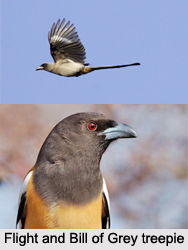 Grey Treepie, which is also known as the Himalayan Treepie is an Indian Bird that bears a scientific name "Dendrocitta formosae". Grey Treepie belongs to the crow family.
Grey Treepie, which is also known as the Himalayan Treepie is an Indian Bird that bears a scientific name "Dendrocitta formosae". Grey Treepie belongs to the crow family.
Category of Grey Treepie
Grey Treepie is an Asian Treepie, a medium-sized and long-tailed member of the crow family.
Distribution of Grey Treepie
Grey Treepie is widely distributed along the foothills of the Himalayan Mountain Range in the Indian States and extending into Indo- China, southern mainland China and Taiwan.
Population of Grey Treepie
The population of Grey Treepie varies in plumage and several are named as subspecies.
Behaviour of Grey Treepie
Grey Treepies are omnivorous birds mostly thriving among dense foliage and in forests. They sometimes take part in mixed species flocks with laughing thrushes, especially the white-throated. Systematically together working through the hill forests, rhododendrons, oaks and other broad leaved trees, especially in the mornings.
Colour of Grey Treepie
Grey Treepie is of the same size as other Dendrocitta species and is separated from them by the overall grey colour of the body.
Races of Grey Treepie
The races of Grey Treepie in the western part of the distribution have a greyish rump and some grey in tail while the eastern forms have a white rump and a black tail. The face and throat are dark and black with a diffuse mask.
Body of Grey treepie
The body of Grey treepie is grey on the underside becoming whiter towards the vent. The back and scapulars are brownish. The crown and nape are greyish and the black wing has a prominent white carpal patch. The vent is rufous and the outer tail feathers and tips of the central feathers are black.
 Geographical Distribution of Grey Treepie
Geographical Distribution of Grey Treepie
Grey Treepie occupies a large geographical range and has several recognised regional forms that differ slightly from one another for instance in colour and tail length. These include occidentalis of the western Himalayan foothills (identified by its slightly longer tail), Himalayan from the central Himalayas east into Thailand and Vietnam. A disjunct population, said to have a smaller or narrower bill, is found in the Eastern Ghats Mountain Range in India, sarkari that is sometimes subsumed into Himalayan. The Southeast Asian races include assimilis, sapiens, sinica, formosae (the nominate race from Taiwan) and insulae (Hainan Island).
Habitat of Grey Treepie
Grey Treepie is largely arboreal and is found in a wide range of habitats including forest, cultivation and human habitation. The distribution range includes India, Nepal, Assam, Burma, Thailand, southern Tibet, Taiwan and Indo-China.
Feeding of Grey Treepie
Grey Treepie is mostly an arboreal feeder but will take some food from the ground especially in cultivated regions. A wide range of insects and other invertebrates are taken including berries, nectar, grain and other seeds and also small reptiles, eggs and nestlings. It sometimes joins mixed-species foraging flocks.
Breeding Range of Grey Treepie
In the foothills of the Himalayas in India, Grey Treepies are known to breeds from 2000 to 6000 feet mainly during the months from May to July.
Nests of Grey Treepie
The nest of Grey Treepie is a shallow cup lined with hair and is built in trees and bushes or clumps of bamboo with 3-4 eggs per clutch.
Voice of Grey Treepie
The voice of Grey treepie is described as harsh and grating, but like other species is quite varied and includes a grating k-r-r-r-r sound as well as more melodious notes not unlike those of the Rufous Treepie. These include a tiddly-aye-kok, ko-ku-la and barking braap...braap...braap calls











